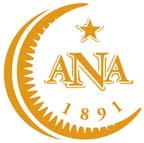U.S. Large Size Notes
During the Civil War, the U.S. government first issued currency for general circulation. The Union had stopped paying out coins, and needed a way to facilitate trade and finance the war. The people were demanding a currency that was guaranteed good by the government. Accordingly, in 1861 the first Federal currency notes were issued.
Between 1861 and 1928, the U.S. issued currency (we refer to it as "large size" because it was bigger than the currency we now use) in many different types. There were Silver and Gold Certificates, backed by precious metal, Legal Tender Notes authorized by Congress, and Federal Reserve Notes issued under the Federal Reserve Act of 1913, among others.
Many of these notes are colorful and beautiful, featuring gorgeous vignettes of events and people of American history. As few people could afford to save quantities of paper money, these notes are generally quite scarce today. This has remained one of the most active areas of the currency market.
- Found 174 items
 1862. $1. F-16. PMG. VF-30. LTN.$1,195.00
1862. $1. F-16. PMG. VF-30. LTN.$1,195.00Portrait of Salmon P. Chase. A popular early Legal Tender note issued during the Civil War. Margins are full with strong color and solid paper.
Item #243998 (1 / 174) 1862. $1. F-16c. PMG. Ch Unc-64. LTN.$4,995.00
1862. $1. F-16c. PMG. Ch Unc-64. LTN.$4,995.00Portrait of Samuel P. Chase. The original greenback design. A lovely example with strong ink and bright paper. Wonderful eye appeal.
Item #250202 (2 / 174) 1863. $5. F-63a. PMG. Ch AU-58. LTN.$4,195.00
1863. $5. F-63a. PMG. Ch AU-58. LTN.$4,195.00A beautiful virtually new note that exhibits more than ample borders, vivid color, and white paper. Eye appeal is excellent!
Item #250964 (3 / 174)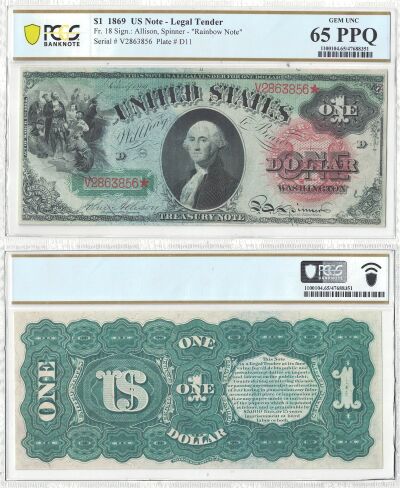 1869. $1. F-18. PCGS. Gem-65. PPQ. LTN.$19,995.00
1869. $1. F-18. PCGS. Gem-65. PPQ. LTN.$19,995.00A beautiful 'Gem' Rainbow Ace that displays excellent blue, green, red, and black inks. The paper is both bright and original. Margins are more than ample and most of the plate number, '11' can be seen in the top margin on the front. Super eye appeal and highly desirable.
Item #249342 (4 / 174) 1869. $1. F-18. PMG. Ch AU-58. LTN.$4,850.00
1869. $1. F-18. PMG. Ch AU-58. LTN.$4,850.00A beautiful 'Rainbow' ace that exhibits strong color, pleasing paper, and full margins. Plenty of eye appeal.
Item #247498 (5 / 174) 1869. $10. F-96. PCGS. Gem-66. PPQ. LTN.$22,500.00
1869. $10. F-96. PCGS. Gem-66. PPQ. LTN.$22,500.00Portrait of Daniel Webster, former US Congressman, Senator, and Secretary of State. A simply stunning 'Rainbow' Jackass that earned its name from its beautiful blend of vibrant green, black, and red inks. In addition, notes were printed on specially prepared paper that contained a strip of blue that was to aide in counterfeit detection. This 'Rainbow' was found on notes only issued under the series 1869. Later series were more traditional and not nearly as colorful. This example is framed by bright nearly even margins. The early intricate design reverse is on display. Fantastic eye appeal and an extremely desirable high end 'Gem'!
Item #247549 (6 / 174) 1869. $5. F-64. PMG. Gem-65. EPQ. LTN.$12,495.00
1869. $5. F-64. PMG. Gem-65. EPQ. LTN.$12,495.00A beautiful 'Rainbow Woodchopper' that offers rich multi-color hues that flow across bright premium paper. Margins are full and well balanced. Great eye appeal!
Item #248921 (7 / 174)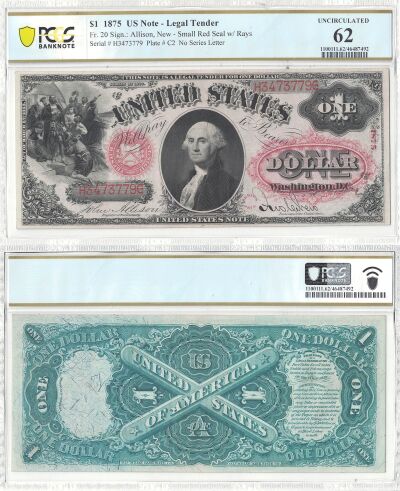 1875. $1. F-20. PCGS. New-62. LTN.$1,595.00
1875. $1. F-20. PCGS. New-62. LTN.$1,595.00An early Washington ace that exhibits strong color and bright paper. Centering is much nicer than would be expected for the grade.
Item #247962 (8 / 174) 1875. $1. F-24. PMG. VF-25. EPQ. LTN.$4,995.00
1875. $1. F-24. PMG. VF-25. EPQ. LTN.$4,995.00Series D. A wonderful early ace with solid color, well balanced margins that show a partial plate number at the center bottom, and plenty of remaining brightness. An 'EPQ' designation has been given for this note even though notes at this level seldom receive such a designation. Only 24 notes are known in all grades according to Track & Price with nothing grading finer than a 55 Net at any grading service.
Item #250136 (9 / 174)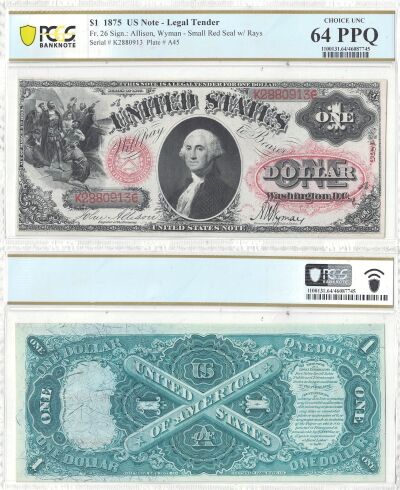 1875. $1. F-26. PCGS. Very Ch-64. PPQ. LTN.$2,895.00
1875. $1. F-26. PCGS. Very Ch-64. PPQ. LTN.$2,895.00An attractive early Washington ace that exhibits pleasing color and bright premium paper.
Item #246670 (10 / 174) 1875. $1. F-26. PMG. Gem-65. EPQ. LTN.$5,595.00
1875. $1. F-26. PMG. Gem-65. EPQ. LTN.$5,595.00A wonderful early 'Washington' ace that combines more than ample margins with great color and bright premium paper. Most of the plate number 60 appears at the center bottom.
Item #128630 (11 / 174) 1878. $2. F-48. PMG. Ch AU-58. LTN.$2,650.00
1878. $2. F-48. PMG. Ch AU-58. LTN.$2,650.00A well centered early 'Jefferson' issue that exhibits strong color, pleasing paper and falls just shy of a new designation.
Item #248422 (12 / 174)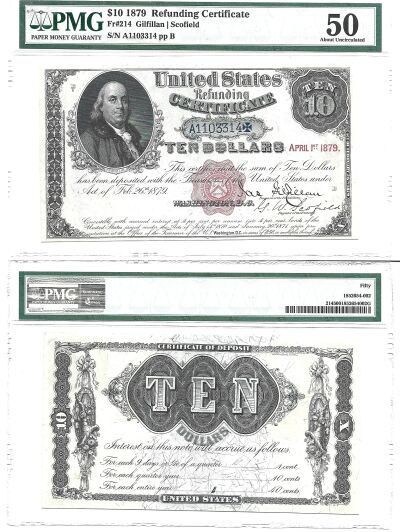 1879. $10. F-214. PMG. AU-50. Refunding Certificat$9,595.00
1879. $10. F-214. PMG. AU-50. Refunding Certificat$9,595.00An attractive example of this unusual interest bearing obligation currency which found popularity with the general public until the interest stopped in 1907. They were issued in an attempt to give the average citizen opportunities to own government securities in low denominations. There are less than 200 known and high-grade examples are always in demand.
Item #246822 (13 / 174) 1880. $1. F-28. PMG. Ch Unc-64. LTN.$2,150.00
1880. $1. F-28. PMG. Ch Unc-64. LTN.$2,150.00A pleasing large brown seal note that offers strong color and a bright appearance.
Item #248961 (14 / 174) 1880. $1. F-30. PCGS. Ch New-63. PPQ. LTN.$1,650.00
1880. $1. F-30. PCGS. Ch New-63. PPQ. LTN.$1,650.00An attractive brown seal that exhibits ample margins with a partial appearance of plate #104 at the bottom on the front. The strong inks blend nicely with the premium paper.
Item #201225 (15 / 174) 1880. $1. F-30. PCGS. Very Ch-64. LTN.$1,595.00
1880. $1. F-30. PCGS. Very Ch-64. LTN.$1,595.00Well centered with strong color and pleasing paper.
Item #247611 (16 / 174) 1880. $1. F-30. PMG. Ch AU-58. LTN.$1,275.00
1880. $1. F-30. PMG. Ch AU-58. LTN.$1,275.00A well centered and attractive large brown seal note that exhibits strong color and a bright appearance.
Item #246712 (17 / 174) 1880. $1. F-30. PMG. Ch Unc-64. EPQ. LTN.$1,850.00
1880. $1. F-30. PMG. Ch Unc-64. EPQ. LTN.$1,850.00An attractive ace that exhibits strong inks and premium paper.
Item #247691 (18 / 174) 1880. $1. F-31. PCGS. Ch AU-58. LTN.$2,650.00
1880. $1. F-31. PCGS. Ch AU-58. LTN.$2,650.00A tougher large red seal issue that displays bright paper and strong inks. Track and price lists 185 known in all grades.
Item #250943 (19 / 174) 1880. $1. F-33. PMG. Gem-65. EPQ. LTN.$11,750.00
1880. $1. F-33. PMG. Gem-65. EPQ. LTN.$11,750.00A beautiful spiked large brown seal example with vivid inks, brilliant white premium paper, and wide margins. Just 44 notes are known in all grades according to Track & Price. Fantastic eye appeal!
Item #250137 (20 / 174) Show more items...
Show more items...
- 174 items found









